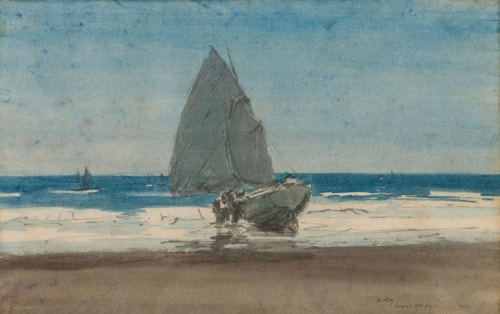
James MCBEY
Newburgh 1883 - Tangier 1959
Biography
Born in a small village a few miles north of Aberdeen, the Scottish artist James McBey had little or no formal training, and from the age of fifteen worked as a bank clerk. He began painting and drawing as a hobby, and in the public library in Aberdeen came across a book on etching. Fascinated by the medium and determined to work as an etcher, despite lacking access to a press, he went so far as to print his first etchings using a domestic laundry roller. By 1902, using the premises of a local blacksmith, McBey had built himself a handmade working press, making the steel rollers out of a propeller shaft taken from a derelict fishing boat. In 1905 one of his etchings was exhibited at the Royal Scottish Academy and two others at the Royal Glasgow Institute. By 1910 he had abandoned his career in banking to devote himself full time to art, travelling to Holland to study Rembrandt’s prints and later visiting Wales, Cornwall, Spain and Morocco. In 1911 he held his first exhibition of etchings in London, which proved highly successful with both critics and collectors, and by 1914 McBey was earning around £1,000 a year from the sale of his etchings and from portrait commissions. During the First World War McBey was appointed an official war artist - at the suggestion of Campbell Dodgson, Keeper of Prints and Drawings at the British Museum - and spent two years recording the military campaigns of the British Expeditionary Force in Egypt. (Over 250 works from this period are today in the collection of the Imperial War Museum in London.) By the 1920s McBey had become one the best known and most successful etchers in Britain, with his landscape etchings and drypoints fetching very high prices. He visited Venice for the first time in 1924, and his etchings of the city account for some of his finest work in the medium. By the end of the 1920s, however, the Depression and the decline of the once-booming market for prints led McBey to focus more on watercolour and oil painting. His technique as a landscape watercolourist developed considerably in the 1930s, resulting in works of remarkable virtuosity. During this decade he also developed a career as a portrait painter, working in oils, although these commissioned works often lack the vitality of his landscape subjects. Although he never joined any artist’s group or exhibition society, McBey continued to work and travel extensively throughout Britain, Europe, Morocco (where he owned a house in Tangier) and America until his death in 1959.


